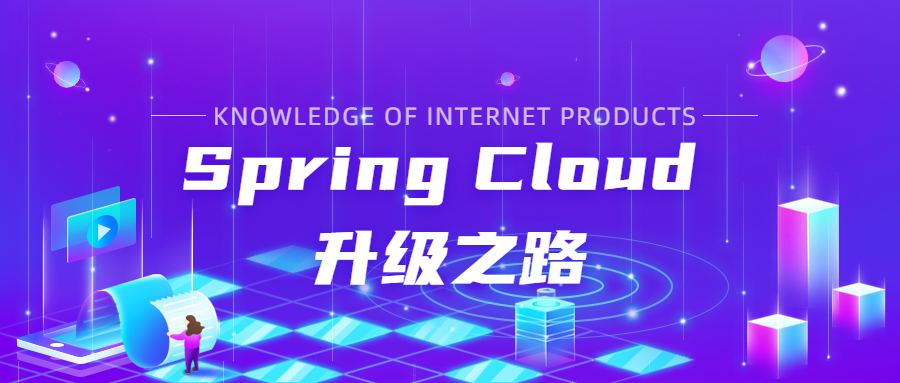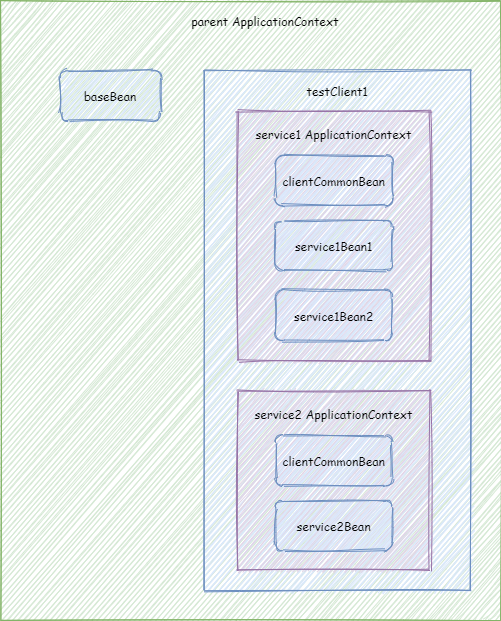SpringCloud升级之路2020.0.x版-8.理解 NamedContextFactory

本系列为之前系列的整理重启版,随着项目的发展以及项目中的使用,之前系列里面很多东西发生了变化,并且还有一些东西之前系列并没有提到,所以重启这个系列重新整理下,欢迎各位留言交流,谢谢!~
spring-cloud-commons 中参考了 spring-cloud-netflix 的设计,引入了 NamedContextFactory 机制,一般用于对于不同微服务的客户端模块使用不同的 子 ApplicationContext 进行配置。
spring-cloud-commons 是 Spring Cloud 对于微服务基础组件的抽象。在一个微服务中,调用微服务 A 与调用微服务 B 的配置可能不同。比较简单的例子就是,A 微服务是一个简单的用户订单查询服务,接口返回速度很快,B 是一个报表微服务,接口返回速度比较慢。这样的话我们就不能对于调用微服务 A 和微服务 B 使用相同的超时时间配置。还有就是,我们可能对于服务 A 通过注册中心进行发现,对于服务 B 则是通过 DNS 解析进行服务发现,所以对于不同的微服务我们可能使用不同的组件,在 Spring 中就是使用不同类型的 Bean。
在这种需求下,不同微服务的客户端有不同的以及相同的配置,有不同的 Bean,也有相同的 Bean。所以,我们可以针对每一个微服务将他们的 Bean 所处于 ApplicationContext 独立开来,不同微服务客户端使用不同的 ApplicationContext。NamedContextFactory 就是用来实现这种机制的。

编写源码:
package com.github.hashjang.spring.cloud.iiford.service.common;
import org.junit.Assert;
import org.junit.Test;
import org.springframework.cloud.context.named.NamedContextFactory;
import org.springframework.context.annotation.AnnotationConfigApplicationContext;
import org.springframework.context.annotation.Bean;
import org.springframework.context.annotation.Configuration;
import org.springframework.core.env.Environment;
import java.util.List;
import java.util.Objects;
public class CommonNameContextTest {
private static final String PROPERTY_NAME = "test.context.name";
@Test
public void test() {
//创建 parent context
AnnotationConfigApplicationContext parent = new AnnotationConfigApplicationContext();
//添加 BaseConfig 相关配置
parent.register(BaseConfig.class);
//初始化 parent
parent.refresh();
//创建 testClient1,默认配置使用 ClientCommonConfig
TestClient testClient1 = new TestClient(ClientCommonConfig.class);
//创建 service1 与 service2 以及指定对应额外的配置类
TestSpec testSpec1 = new TestSpec("service1", new Class[]{Service1Config1.class, Service1Config2.class});
TestSpec testSpec2 = new TestSpec("service2", new Class[]{Service2Config.class});
//设置 parent ApplicationContext 为 parent
testClient1.setApplicationContext(parent);
//将 service1 与 service2 的配置加入 testClient1
testClient1.setConfigurations(List.of(testSpec1, testSpec2));
BaseBean baseBean = testClient1.getInstance("service1", BaseBean.class);
System.out.println(baseBean);
//验证正常获取到了 baseBean
Assert.assertNotNull(baseBean);
ClientCommonBean commonBean = testClient1.getInstance("service1", ClientCommonBean.class);
System.out.println(commonBean);
//验证正常获取到了 commonBean
Assert.assertNotNull(commonBean);
Service1Bean1 service1Bean1 = testClient1.getInstance("service1", Service1Bean1.class);
System.out.println(service1Bean1);
//验证正常获取到了 service1Bean1
Assert.assertNotNull(service1Bean1);
Service1Bean2 service1Bean2 = testClient1.getInstance("service1", Service1Bean2.class);
System.out.println(service1Bean2);
//验证正常获取到了 service1Bean2
Assert.assertNotNull(service1Bean2);
BaseBean baseBean2 = testClient1.getInstance("service2", BaseBean.class);
System.out.println(baseBean2);
//验证正常获取到了 baseBean2 并且 baseBean2 就是 baseBean
Assert.assertEquals(baseBean, baseBean2);
ClientCommonBean commonBean2 = testClient1.getInstance("service2", ClientCommonBean.class);
System.out.println(commonBean2);
//验证正常获取到了 commonBean2 并且 commonBean 和 commonBean2 不是同一个
Assert.assertNotNull(commonBean2);
Assert.assertNotEquals(commonBean, commonBean2);
Service2Bean service2Bean = testClient1.getInstance("service2", Service2Bean.class);
System.out.println(service2Bean);
//验证正常获取到了 service2Bean
Assert.assertNotNull(service2Bean);
}
@Configuration(proxyBeanMethods = false)
static class BaseConfig {
@Bean
BaseBean baseBean() {
return new BaseBean();
}
}
static class BaseBean {}
@Configuration(proxyBeanMethods = false)
static class ClientCommonConfig {
@Bean
ClientCommonBean clientCommonBean(Environment environment, BaseBean baseBean) {
//在创建 NamedContextFactory 里面的子 ApplicationContext 的时候,会指定 name,这个 name 对应的属性 key 即 PROPERTY_NAME
return new ClientCommonBean(environment.getProperty(PROPERTY_NAME), baseBean);
}
}
static class ClientCommonBean {
private final String name;
private final BaseBean baseBean;
ClientCommonBean(String name, BaseBean baseBean) {
this.name = name;
this.baseBean = baseBean;
}
@Override
public String toString() {
return "ClientCommonBean{" +
"name='" + name + '\'' +
", baseBean=" + baseBean +
'}';
}
}
@Configuration(proxyBeanMethods = false)
static class Service1Config1 {
@Bean
Service1Bean1 service1Bean1(ClientCommonBean clientCommonBean) {
return new Service1Bean1(clientCommonBean);
}
}
static class Service1Bean1 {
private final ClientCommonBean clientCommonBean;
Service1Bean1(ClientCommonBean clientCommonBean) {
this.clientCommonBean = clientCommonBean;
}
@Override
public String toString() {
return "Service1Bean1{" +
"clientCommonBean=" + clientCommonBean +
'}';
}
}
@Configuration(proxyBeanMethods = false)
static class Service1Config2 {
@Bean
Service1Bean2 service1Bean2() {
return new Service1Bean2();
}
}
static class Service1Bean2 {
}
@Configuration(proxyBeanMethods = false)
static class Service2Config {
@Bean
Service2Bean service2Bean(ClientCommonBean clientCommonBean) {
return new Service2Bean(clientCommonBean);
}
}
static class Service2Bean {
private final ClientCommonBean clientCommonBean;
Service2Bean(ClientCommonBean clientCommonBean) {
this.clientCommonBean = clientCommonBean;
}
@Override
public String toString() {
return "Service2Bean{" +
"clientCommonBean=" + clientCommonBean +
'}';
}
}
static class TestSpec implements NamedContextFactory.Specification {
private final String name;
private final Class<?>[] configurations;
public TestSpec(String name, Class<?>[] configurations) {
this.name = name;
this.configurations = configurations;
}
@Override
public String getName() {
return name;
}
@Override
public Class<?>[] getConfiguration() {
return configurations;
}
}
static class TestClient extends NamedContextFactory<TestSpec> {
public TestClient(Class<?> defaultConfigType) {
super(defaultConfigType, "testClient", PROPERTY_NAME);
}
}
}
结果输出为:
com.github.hashjang.spring.cloud.iiford.service.common.CommonNameContextTest$BaseBean@3faf2e7d
ClientCommonBean{name='service1', baseBean=com.github.hashjang.spring.cloud.iiford.service.common.CommonNameContextTest$BaseBean@3faf2e7d}
Service1Bean1{clientCommonBean=ClientCommonBean{name='service1', baseBean=com.github.hashjang.spring.cloud.iiford.service.common.CommonNameContextTest$BaseBean@3faf2e7d}}
com.github.hashjang.spring.cloud.iiford.service.common.CommonNameContextTest$Service1Bean2@4648ce9
com.github.hashjang.spring.cloud.iiford.service.common.CommonNameContextTest$BaseBean@3faf2e7d
ClientCommonBean{name='service2', baseBean=com.github.hashjang.spring.cloud.iiford.service.common.CommonNameContextTest$BaseBean@3faf2e7d}
Service2Bean{clientCommonBean=ClientCommonBean{name='service2', baseBean=com.github.hashjang.spring.cloud.iiford.service.common.CommonNameContextTest$BaseBean@3faf2e7d}}
代码中实现了这样一个 Context 结构:

图中的被包含的 ApplicationContext 可以看到外层 ApplicationContext 的 Bean,也就是通过对被包含的 ApplicationContext 调用 getBean(xxx) 可以获取到外层 ApplicationContext 的 Bean (其实外层就是 parent ApplicationContext),但是外层的看不到内层私有的 Bean。
在我们的测试代码中,首先,创建了一个 AnnotationConfigApplicationContext。这个其实就是模拟了我们平常使用 Spring 框架的时候的根核心 ApplicationContext,所以我们将其命名为 parent。我们向里面注册了 BaseConfig,BaseConfig 里面的 BaseBean 会注册到 parent。之后我们 建 testClient1,默认配置使用 ClientCommonConfig。如果我们指定了 testClient1 的 parent ApplicationContext 为 parent,那么 parent 里面的 Bean 都能被 testClient1 里面的子 ApplicationContext 访问到。然后,我们创建 service1 与 service2 以及指定对应额外的配置类。service1 会创建 ClientCommonConfig、Service1Config1 和 Service1Config2 里面配置的 Bean。service2 会创建 ClientCommonConfig 和 Service2Config 里面配置的 Bean。

NamedContextFactory 的核心方法是 public <T> T getInstance(String name, Class<T> type),通过这个方法获取 NamedContextFactory 里面的子 ApplicationContext 里面的 Bean。源码是:
/**
* 获取某个 name 的 ApplicationContext 里面的某个类型的 Bean
* @param name 子 ApplicationContext 名称
* @param type 类型
* @param <T> Bean 类型
* @return Bean
*/
public <T> T getInstance(String name, Class<T> type) {
//获取或者创建对应名称的 ApplicationContext
AnnotationConfigApplicationContext context = getContext(name);
try {
//从对应的 ApplicationContext 获取 Bean,如果不存在则会抛出 NoSuchBeanDefinitionException
return context.getBean(type);
}
catch (NoSuchBeanDefinitionException e) {
//忽略 NoSuchBeanDefinitionException
}
//没找到就返回 null
return null;
}
protected AnnotationConfigApplicationContext getContext(String name) {
//如果 map 中不存在,则创建
if (!this.contexts.containsKey(name)) {
//防止并发创建多个
synchronized (this.contexts) {
//再次判断,防止有多个等待锁
if (!this.contexts.containsKey(name)) {
this.contexts.put(name, createContext(name));
}
}
}
return this.contexts.get(name);
}
//根据名称创建对应的 context
protected AnnotationConfigApplicationContext createContext(String name) {
AnnotationConfigApplicationContext context = new AnnotationConfigApplicationContext();
//如果 configurations 中有对应名称的配置类,则注册之
if (this.configurations.containsKey(name)) {
for (Class<?> configuration : this.configurations.get(name).getConfiguration()) {
context.register(configuration);
}
}
//如果 configurations 中有名称开头为 default. 的配置类,则注册之
for (Map.Entry<String, C> entry : this.configurations.entrySet()) {
if (entry.getKey().startsWith("default.")) {
for (Class<?> configuration : entry.getValue().getConfiguration()) {
context.register(configuration);
}
}
}
//注册 PropertyPlaceholderAutoConfiguration,这样可以解析 spring boot 相关的 application 配置
//注册默认的配置类 defaultConfigType
context.register(PropertyPlaceholderAutoConfiguration.class, this.defaultConfigType);
//将当前 context 的名称,放入对应的属性中,在配置类中可能会用到
//我们上面举得例子,就是通过 environment.getProperty() 获取了这个属性
context.getEnvironment().getPropertySources().addFirst(new MapPropertySource(this.propertySourceName,
Collections.<String, Object>singletonMap(this.propertyName, name)));
if (this.parent != null) {
// Uses Environment from parent as well as beans
context.setParent(this.parent);
//spring boot 可以打包成一种 fatjar 的形式,将依赖的 jar 包都打入同一个 jar 包中
//fatjar 中的依赖,通过默认的类加载器是加载不正确的,需要通过定制的类加载器
//由于 JDK 11 LTS 相对于 JDK 8 LTS 多了模块化,通过 ClassUtils.getDefaultClassLoader() 有所不同
//在 JDK 8 中获取的就是定制的类加载器,JDK 11 中获取的是默认的类加载器,这样会有问题
//所以,这里需要手动设置当前 context 的类加载器为父 context 的类加载器
context.setClassLoader(this.parent.getClassLoader());
}
//生成展示名称
context.setDisplayName(generateDisplayName(name));
context.refresh();
return context;
}

我们这一节详细分析了 Spring Cloud 的基础 NamedContextFactory,搞清楚了其中的原理,并且举了一个简单的例子。接下来我们会详细分析下如何使用以及分析改造一个 Spring Cloud 组件。
微信搜索“我的编程喵”关注公众号,每日一刷,轻松提升技术,斩获各种offer:

SpringCloud升级之路2020.0.x版-8.理解 NamedContextFactory的更多相关文章
- SpringCloud升级之路2020.0.x版-1.背景
本系列为之前系列的整理重启版,随着项目的发展以及项目中的使用,之前系列里面很多东西发生了变化,并且还有一些东西之前系列并没有提到,所以重启这个系列重新整理下,欢迎各位留言交流,谢谢!~ Spring ...
- SpringCloud升级之路2020.0.x版-41. SpringCloudGateway 基本流程讲解(1)
本系列代码地址:https://github.com/JoJoTec/spring-cloud-parent 接下来,将进入我们升级之路的又一大模块,即网关模块.网关模块我们废弃了已经进入维护状态的 ...
- SpringCloud升级之路2020.0.x版-6.微服务特性相关的依赖说明
本系列代码地址:https://github.com/HashZhang/spring-cloud-scaffold/tree/master/spring-cloud-iiford spring-cl ...
- SpringCloud升级之路2020.0.x版-10.使用Log4j2以及一些核心配置
本系列代码地址:https://github.com/HashZhang/spring-cloud-scaffold/tree/master/spring-cloud-iiford 我们使用 Log4 ...
- SpringCloud升级之路2020.0.x版-43.为何 SpringCloudGateway 中会有链路信息丢失
本系列代码地址:https://github.com/JoJoTec/spring-cloud-parent 在开始编写我们自己的日志 Filter 之前,还有一个问题我想在这里和大家分享,即在 Sp ...
- SpringCloud升级之路2020.0.x版-29.Spring Cloud OpenFeign 的解析(1)
本系列代码地址:https://github.com/JoJoTec/spring-cloud-parent 在使用云原生的很多微服务中,比较小规模的可能直接依靠云服务中的负载均衡器进行内部域名与服务 ...
- SpringCloud升级之路2020.0.x版-34.验证重试配置正确性(1)
本系列代码地址:https://github.com/JoJoTec/spring-cloud-parent 在前面一节,我们利用 resilience4j 粘合了 OpenFeign 实现了断路器. ...
- SpringCloud升级之路2020.0.x版-2.微服务框架需要考虑的问题
本系列为之前系列的整理重启版,随着项目的发展以及项目中的使用,之前系列里面很多东西发生了变化,并且还有一些东西之前系列并没有提到,所以重启这个系列重新整理下,欢迎各位留言交流,谢谢!~ 上图中演示了一 ...
- SpringCloud升级之路2020.0.x版-3.Eureka Server 与 API 网关要考虑的问题
本系列为之前系列的整理重启版,随着项目的发展以及项目中的使用,之前系列里面很多东西发生了变化,并且还有一些东西之前系列并没有提到,所以重启这个系列重新整理下,欢迎各位留言交流,谢谢!~ 之前我们提到了 ...
随机推荐
- 20201123 实验一《Python程序设计》实验报告
20201123 2020-2021-2 <Python程序设计>实验一报告 课程:<Python程序设计> 班级:2011班 姓名:晏鹏捷 学号:20201123 实验教师: ...
- 我成了 GitHub Star
能够成为官方认证的 GitHub Star(明星)我和你们一样十分震惊! 可能很多读者不知道这个 GitHub Star 是什么,我先来介绍下它: GitHub Stars(明星)是 GitHub 官 ...
- testt
一级标题 二级标题 三级标题 四级标题 l 1
- Windows10 准备/安装React研发环境
安装NodeJS环境,附带NPM 因为React依赖NPM(Node.js Package Manager)来安装,所以我们可以先安装Node.Js环境. Node.Js会自动带NPM组件和自动安装配 ...
- oracle :如何测试数据库安装是否成功
要测试数据安装是否成功,可按顺序执行以下两个步骤: 测试步骤 1: 请执行操作系统级的命令: tnsping orcl (如果出现[TNS-03505:无法解析名称]的提示错误: 那就改为tnspi ...
- Linux系统下安装NodeJS
下载NodeJS二进制压缩包 去NodeJS官网https://nodejs.org/zh-cn/,下载二进制压缩包,进入下载页面之后你将看到很多下载选项: 源码不包含bin目录,不是可运行的应用程序 ...
- XCTF simple js
思路分析: 进入靶场, 随便输入,肯定是错误的,f12看下源码,结合题目说js,把js代码单独拿出来看看. function dechiffre(pass_enc){ var pass = " ...
- XCTF csaw2013reversing2
题目描述:听说运行就能拿到Flag,不过菜鸡运行的结果不知道为什么是乱码 一.先运行看看. 果然乱码. 二.查壳 三.是pe文件,可以拖入od和ida进行动态和静态分析. 1.对主函数进行反编译一下. ...
- ESP32高分辨率计时器笔记
尽管FreeRTOS提供了软件计时器,但这些计时器有一些限制: 最大分辨率等于RTOS滴答周期 计时器回调从低优先级任务分派 硬件计时器不受这两个限制,但是通常它们使用起来不太方便.例如,应用组件可能 ...
- java基础---设计模式(1)
出处:https://blog.csdn.net/zhangerqing/article/details/8194653 java的设计模式分为三大类 创建型模式: 工厂方法模式.抽象工厂模式.单例模 ...
